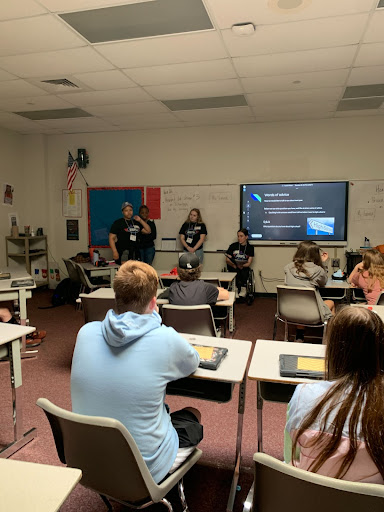
On April 11, the White House called on Congress to make a historic investment of $46.1 billion for National Drug Control Program (ONDCP) agencies to counter the rapidly growing fentanyl crisis through a multidimensional approach. This budget request represented a $5 billion increase from 2022, including more funding to reduce the supply of illicit drugs like fentanyl and stop drug trafficking. It increased funding to support the expansion of prevention, treatment, harm reduction and recovery support services. Parkway School District and its partner coalition, Alliance for Healthy Communities (AHC), are among the 100 nationwide recipients of the ONDCPÔÇÖs Drug-Free Community grants.
What is fentanyl and lacing?
Fentanyl is a synthetic opioid made in labs, unlike traditional opioids farmed from poppy. There are two categories of fentanyl: pharmaceutical fentanyl and illicitly manufactured fentanyl (IMF). Hospitals and doctors use pharmaceutical fentanyl under medical supervision to provide anesthesia for people requiring surgery and for patients with cancer. IMF is produced in foreign clandestine labs, mostly in Mexico, smuggled into the US and sold on the illegal drug market.
Fentanyl is 50 times more potent than heroin and 100 times more potent than morphine. It is highly addictive, making it profitable for the cartels to produce and mix into other drugs through lacing.
Fentanyl-laced drugs are extremely dangerous, not only because of their potency but also because many people are unaware that their drugs are laced with fentanyl. In addition to being laced into counterfeit pills such as Percocet, Xanax and Adderall, fentanyl lacing is also seen with marijuana and vaping liquids. Because there is no official oversight or quality control over counterfeit pills, laced weed and vapes can contain unknown quantities ÔÇö often lethal doses ÔÇö of fentanyl, sometimes with none of the labeled drug or chemical. Unknowingly ingesting these substances not only causes more dependence and faster withdrawals but can be deadly ÔÇöÔÇåeven a small dose the size of a grain of sand can kill and is considered a poison by many.
What is the problem, and why is the urgency?
Fentanyl is the country’s number one cause of overdose deaths, surpassing heroin by a 75% to 1% margin. Although the Centers for Disease Control and Prevention (CDC) issued its first fentanyl alert in 2015, the problem has skyrocketed. Drug overdose deaths in the U.S. increased by 28.5% between April 2020 and April 2021, with three out of four overdose deaths involving synthetic opioids like fentanyl. In 2021, fentanyl claimed 70,601 reported overdose deaths.
Fentanyl is the leading cause of death in people ages 18-45, exceeding deaths due to car accidents, gun violence, suicide and COVID-19 since 2020. But, youth are disproportionately affected by it due to three reasons: drugs laced with fentanyl have become more available and accessible because of social media platforms; young people, particularly those who are opioid naive, have a low tolerance threshold for fentanyl; and the lack of awareness about the risks of fentanyl and its presence in other substances.
News reports of young people dying or facing death after taking just one pill or dose of fentanyl span across the country, including St. Louis and St. Charles.
ÔÇ£I am not aware of fentanyl presence in our schools,ÔÇØ Director of Health Services at Parkway Diane Brown said. ÔÇ£Students should stay away from illegal drugs and only take medication given to them by their parents or a medical provider.ÔÇØ
According to the CDC, counterfeit pills, laced weed and fentanyl mixed in fragrant vape juices may contain deadly levels of the substance, and one wouldnÔÇÖt be able to see, taste or smell. Although fentanyl test strips are available to check for its presence, officials warn that they may not be fully reliable, with the safest action being to avoid such substances altogether.
For many, one pill or one dose ÔÇö sometimes their first ÔÇö can lead to their last breath. This inspired the DEAÔÇÖs ÔÇ£one pill can killÔÇØ campaign. Recognizing the signs of an overdose and calling 911 can save lives. Signs of overdose include falling asleep or losing consciousness; slow, weak or no breathing; choking or gurgling sounds; a limp body; and cold, clammy or discolored skin ÔÇö especially in lips and nails. Naloxone (Narcan) is a life-saving medication that can reverse an overdose of fentanyl and other opioids when given in time. On March 29, 2023, the U.S. Food and Drug Administration approved Narcan nasal spray for over-the-counter nonprescription use.
ÔÇ£If you notice any signs or symptoms of use or overdose while at school, immediately reach out to a faculty member, administrator, nurse, counselor, or teacher,ÔÇØ Brown said. ÔÇ£We currently stock Naloxone in all of our buildings, and nurses have been trained on proper administration.ÔÇØ
As the government, law enforcement, border control agencies, health professionals and schools do their part, everyone, including students and parents, has a heightened role in combatting this crisis. Although focusing efforts on controlling supply is tempting, there is evidence that supply-side interventions can work better if the program includes demand reduction. Being proactive and focusing on prevention and abstinence can be our best tool to starve the cartels and end the crisis.
Steps to stop fentanyl
Be aware and be educated
One of the goals of AHC is to collaborate with students, parents, educators and local organizations within the district to identify, educate and take actions that prevent youth substance abuse and reduce harm. This goal is supported through funding from the ONDCP Drug-Free Communities Grant.
ÔÇ£Most school districts do not have the funds to educate the community. If you look at your community like a fish bowl, the school takes care of the fish, and we ensure the fish has clean water [by educating the studentÔÇÖs environment – parents, families and the community],ÔÇØ AHC youth program director Julie Knost said.
Closing the teen knowledge gap is the first step. Because of lacing, the majority of teens are unaware of their consumption of fentanyl. According to a nationwide survey of 1,500 young Americans aged 13 to 24, only 31% were aware of fentanyl, and only 36% knew fentanyl is dangerous. 
ÔÇØTalk about it. Parents talking to kids about substance use can lower their risk of use by 50%,ÔÇØ Knost said. ÔÇ£Over the years, I have talked to many kids and adults who didnÔÇÖt realize vapes had nicotine in them. And then we are mad because they get addicted? We need to be having hard conversations. Education is key.ÔÇ£┬á
Parents also need to educate themselves about this relatively new drug, its dangers and its rapidly evolving usage. Research published in Science Daily shows that ÔÇïÔÇïparents have more influence than they might realize to prevent substance use in children.
ÔÇ£Conversations can start as early as Pre-K. If your [parents] donÔÇÖt know where to start, [there] are two amazing resources. Talk about It MO is supported by our regional prevention organization, PreventEd. Talk. They Hear You program has a great website and a very useful app, [where] you can get tips on how to incorporate drug prevention issues into a situation. It may be related to sports, parties, sleepovers or any such situation,ÔÇØ Knost said. ÔÇ£Additionally, parents must lock up or dispose of medications at home. 67% of teens report getting medications they misuse from friends and family. If the only thing we did was cut out that source, we could make a big difference.ÔÇØ┬á
Being vigilant on social media
In February, Chicago families of more than 50 overdose victims filed a lawsuit against Snapchat, accusing the app of enabling drug dealers. The families say the social media platform enables drug dealers to sell fake prescription pills laced with deadly doses of fentanyl to minors and young adults. According to the lawsuit, from 2020-22, Snapchat was involved in over 75% of the fentanyl poisoning deaths of children between the ages of 13 to 18 and that SnapchatÔÇÖs system of automatically deleting messages makes illegal activities harder to track, thereby more attractive to drug dealers.┬á
ÔÇ£Online or offline, students simply need to know they should never try to obtain medication from anyone other than their doctor,ÔÇØ Knost said.
Avoiding connecting to strangers on social media, refraining from commenting on posts from unknown senders, keeping personal information private and avoiding using money-exchanging apps are some of the steps social media users can take to avoid falling prey to dangerous activity. Additionally, users should take the initiative to block and notify social media and authorities of suspicious people. Social media platforms such as Facebook and Snapchat have listed guidelines and rules that users may not use their platforms for illegal activities. The Senate Judiciary Committee recently introduced The Cooper-Davis Act, which holds tech companies accountable for online drug transactions. However, policies take time to pass and enact, and DEA officials urge social media users to be aware of drug trafficking threats on smartphone apps and to stay vigilant.
Assume every illegal substance is laced and lethal
DEA research shows that six out of 10 pills laced with fentanyl contain a potentially lethal dose. Reinforcing the danger that ÔÇ£one pill can kill,ÔÇØ health officials urge people to say no to experimentation.
ÔÇ£Drugs affect your brain during the development phase. [Students] know that drugs are not good for you, but it is important to know that they can hurt you in the long run. [Keeping away from harmful substances] is an investment into your future and your life. That is the scary piece,ÔÇØ ONDCP director Dr. Rahul Gupta said. ÔÇ£The other thing is, there are so many fun things you can do, and you have the opportunity to do so much more. If you want to experiment, experiment with life [through healthy activities] and not harmful substances. Listen to parents and others who are telling you the same message.ÔÇØ┬á
Research shows that students should go beyond ÔÇÿjust saying noÔÇÖ and be assertive in their decision. They should develop strategies and foster sound mental health to withstand peer pressure and develop long-lasting healthy decisions.
ÔÇ£One of the first things we all need to focus on is our mental health. What we see [and] hear is most young people use substances as a coping mechanism. We all need a support system for stressful times, friends who want the best for us. Not saying this is always easy, but more of our youth do not use drugs than do. Find your people,ÔÇØ Knost said.
Build your support team

A study published in Psychology Today showed that peer selection might play a larger role than peer influence in the development of substance use over long developmental periods. Choosing like-minded friends that prioritize health and safety is essential. Behavioral health experts encourage teenagers to know who their peers are, stand up for their beliefs, and have at least one friend who successfully resists negative peer pressure.
ÔÇ£Students can surround themselves with people that prioritize healthy choices, avoid harmful situations and substances,ÔÇØ┬á sophomore Jacob Burch said. ÔÇ£I feel like we need to make it more known that there are many people out there that don’t do these [drugs] than those that do. I feel like that can give good peer pressure to the other people that are around them that it’s great to stay clean and it’s great that they are making these good decisions.ÔÇØ
Burch is one of the high school heroes with the Parkway Peers Advocating for Total Health (PATH) program. PATH is a teen-led initiative geared to prevent and reduce studentsÔÇÖ use of alcohol, e-cigarettes, marijuana and other drugs and build resiliency and support systems. The program is open to all high school students interested in facilitating meaningful lessons ranging from smoking prevention to character education.┬á
ÔÇ£My inspiration to join PATH comes from my family. In my family, we prioritize avoiding bad things [and] making good choices,ÔÇØ Burch said. ÔÇ£I have a brother that is in middle school, he will be in eighth grade next year. So. I am trying to teach the people around him and our community to make good decisions so they can have better lives.ÔÇØ
Positive attachment to parents has consistently been identified as a protective factor against illicit drug and alcohol use among adolescents in several studies. 
ÔÇ£There is help available. Talk to your parents. Parkway has a great counseling system, and resources are available. Give the adults in your life a chance to help. They are more understanding than you think,ÔÇ£ Knost said.┬á
Get involved in activities that interest you
Iceland is known for its radical turnaround in youth substance use and currently tops the European table for the cleanest-living teens. The percentage of 15 and 16-year-olds consuming alcohol plummeted from 42% in 1998 to 5% in 2016; Cannabis is down from 17% to 7%; smoking cigarettes fell from 23% to just 3%. Iceland achieved these results through three actions: Curfew for 13 to 16-year-olds after 10 p.m. in winter and after midnight in summer, regular involvement in organized kids’ sports and activities and increased parental presence.
ÔÇ£We all need opportunities to experience natural highs. It means getting involved [in] band, sports, debate, reading [or other activites],ÔÇØ Knost said. ÔÇ£The activities not only allow natural highs but are also healthy ways to beat stress.ÔÇØ┬á
The benefits of discovering oneÔÇÖs own ÔÇÿnatural highsÔÇÖ goes far beyond drug prevention. They help people find passion, keep them motivated and drive oneÔÇÖs success. Above all, these positive effects are long-lasting, potentially for a lifetime.
Choose to be a role model and a leader. 
Experts say prevention and staying clean is one of the most important decisions people make. 
ÔÇ£Every student that chooses to be healthy and stay away from harmful substances is a leader [that] needs to be celebrated,ÔÇØ Burch said. ÔÇ£The reward for the people is experiencing a better life without mental issues and a limited mental capacity. Now taking the next step and spreading that message and happiness to others is a bigger reward.ÔÇ£┬á
Burch urges students to join the PATH program. Through age-appropriate conversations, PATH educates students about the unhealthy consequences of drug use and the benefits of choosing a healthy lifestyle. The ultimate goal of PATH is to empower each student to have the attitude to ÔÇ£Learn It, Live It, and Pass It On.ÔÇØ
ÔÇ£I remember in the first-semester teaching, there was one day that we taught multiple lessons, and the first class felt like gravity as if students didn’t want to listen ÔÇö and it felt like I didn’t do much. But then the next class was participating in the discussions. It felt like they were listening to what we were saying and understanding how to become better. That was really good, at least for me to see that. So we can help,ÔÇØ Burch said. ÔÇ£The conversations and discussions can help them, not just today, but throughout the rest of their lives. Anyone can become a PATH leader, which is one of the best ways to stop this drug crisis.ÔÇØ




![Gazing up from the stage, junior Joseph McCurdy who played Peter Pan in the school play, Lost Girl, sits next to senior Juliana Rogers, who plays Wendy Darling, during a theater rehearsal. McCurdyÔÇÖs passion for theater began when he observed a West High production in middle school. ÔÇ£I've been in the high school theater program since I was a freshman. I've always loved theater, but [what prompted me to join] was [when] I went to see [a performance here] when I was in middle school, and it was super cool,ÔÇØ McCurdy said.](https://pwestpathfinder.com/wp-content/uploads/2025/11/IMG_6535-1200x798.jpeg)

![Standing tall, stacked in a precise formation, the cheer team strikes a signature pose during halftime on Sept. 12 at the varsity football game. Nearly a month after this performance, the cheer team performed at the Missouri Cheerleading Coaches Association (MCCA) regional competition on Oct. 4, 2025. ÔÇ£We've all come [to] work together a lot more,ÔÇØ sophomore Elyssa Philippi said. ÔÇ£We're a lot closer than we were [earlier in the season] and going to state has made us closer [in] trying to work with each other, learn [new] skills and make our team better.ÔÇØ](https://pwestpathfinder.com/wp-content/uploads/2025/11/DSC5139-1.jpg)
![Handing out candy to excited trunk-or-treaters, President of the United Nations ChildrenÔÇÖs Fund club and junior Sara Ashok represents that group. Ashok was eager to participate in this event for multiple reasons. ÔÇ£I really wanted to be a part of the event because I get to help create memories for kids and spend time with my friends, spreading the things [I'm passionate about],ÔÇØ Ashok said.](https://pwestpathfinder.com/wp-content/uploads/2025/11/DSC_8648-1-1200x800.jpg)

![Smiling in a sea of Longhorns, Fox 2 reporter Ty Hawkins joins junior Darren Young during the morning Oct. 3 pep rally. The last time West was featured in this segment was 2011. ÔÇ£[I hope people see this and think] if you come to [Parkway] West, you will have the time of your life because there are so many fun activities to do that make it feel like you belong here. I was surprised so many people attended, but it was a lot of fun,ÔÇØ Young said.](https://pwestpathfinder.com/wp-content/uploads/2025/10/Edited2-1200x798.jpg)
![West High seniors and families listen as a representative of The Scholarship Foundation of St. Louis, Teresa Steinkamp, leads a Free Application for Federal Student Aid (FAFSA) workshop. This session, held in the library, provided guidance on financial aid, scholarships and student loan options. ÔÇ£This event is very beneficial for any seniors who are applying to or considering applying to colleges after high school [because] the cost of college is on the rise for seniors and parents,ÔÇØ college and career counselor Chris Lorenz said.](https://pwestpathfinder.com/wp-content/uploads/2025/09/DSC_4478-1200x778.jpg)
![Senior Kamori Berry walks across the field during halftime at the Homecoming football game on Sept. 12. During the pep assembly earlier that day, she was pronounced Homecoming Queen. ÔÇ£I thought it was nice that the crowd [started] cheering right away. I know [my friends] were really excited for me, and my family was happy because typically non-white people don't win,ÔÇØ Berry said.](https://pwestpathfinder.com/wp-content/uploads/2025/09/DSC7046-Enhanced-NR-1200x798.jpg)


